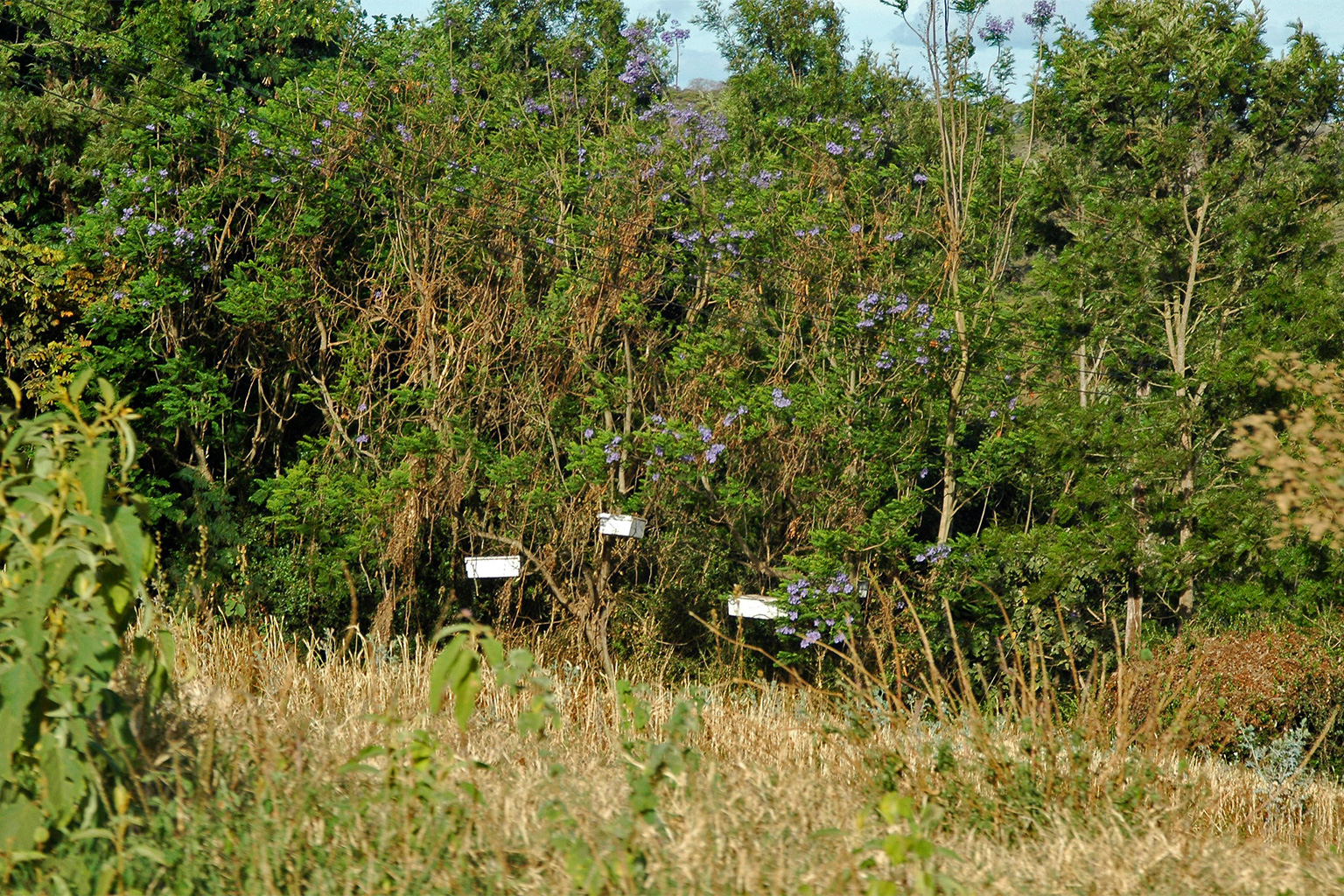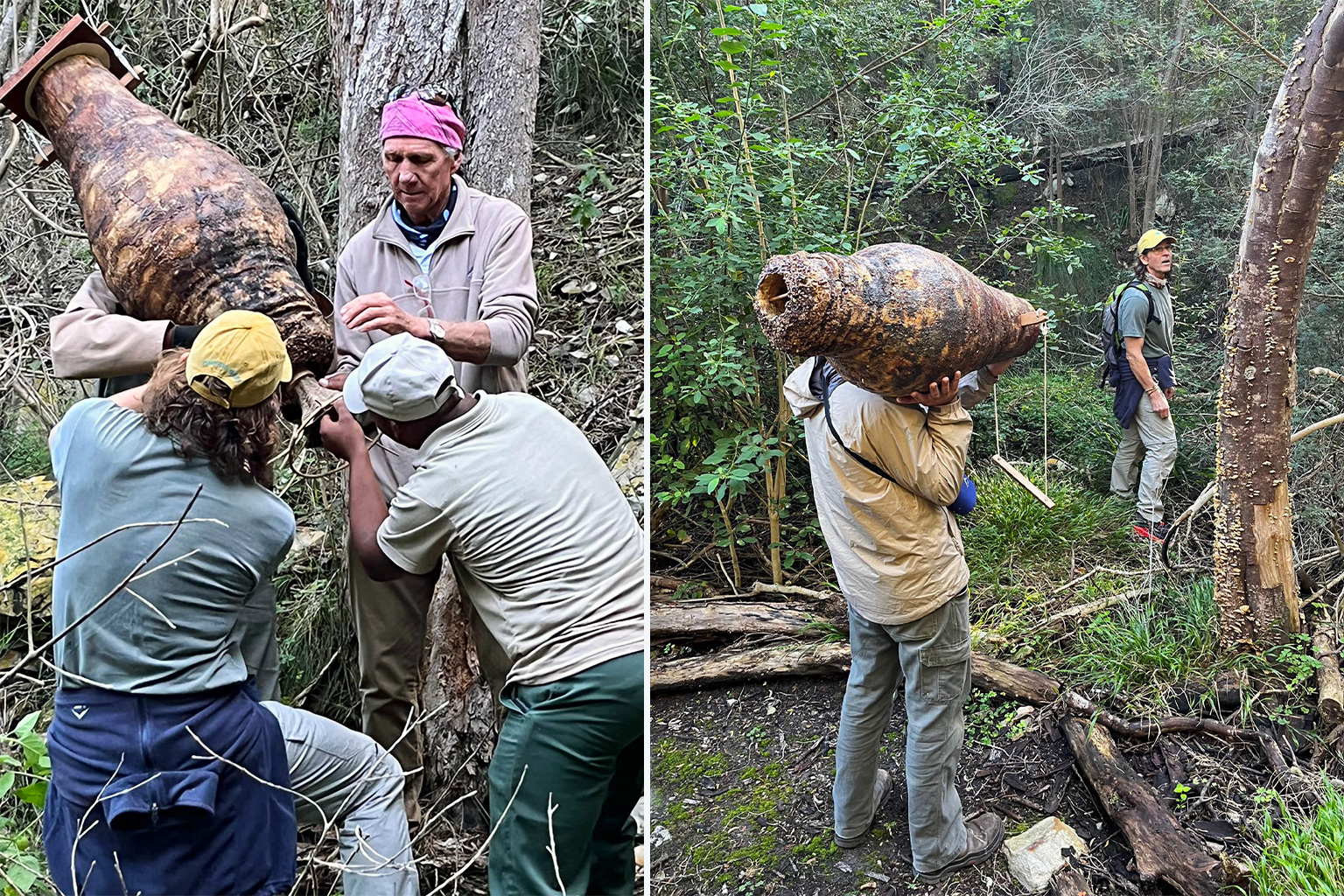- Tanzanian beekeepers prefer traditional log beehives to modern hanging frame beehives, says a new study.
- Traditional beehives have a negative impact on surrounding woodlands in the country’s semiarid Chemba district, according to researchers.
- The high cost of modern hives are one deterrent to their wider adoption, but so are strong cultural attachments to traditional beekeeping.
- South African-pioneered agave log hives mimic traditional ones and could offer an alternative.
Tanzania is Africa’s second-biggest producer of honey, and to get it to the next level, the country’s government and aid agencies want beekeepers to adopt hanging-frame beehive designs to increase their production and income. But beekeepers have been reluctant to abandon their traditional hives made from hollow logs. What do they know that the technical experts don’t?
The latter are promoting hanging frame beehives, a design originating in Europe in the 1800s. These are rectangular hives made out of fast-growing commercial timber species like cypress and pine, into which removable wood frames are slotted that hold the honeycombs. Traditional hives across East Africa are made from hollowed-out logs or bark peeled from living trees to maintain a cylindrical shape.
For a study published recently in Tropical Conservation Science, researchers from the University of Dar es Salaam’s Institute of Resource Assessment interviewed 74 beekeepers from four villages in the semiarid Chemba district of Dodoma, in central Tanzania, about their use of hives. Just six of them used modern hives exclusively. Twenty-four used a combination of modern and traditional hives, and 44 respondents relied entirely on traditional log hives.
Log hives in Chemba are mostly made from acacia trees cut down outside of community forest protected areas, putting additional pressure on woodlands that are already highly degraded from charcoal production, the study says.


Lead author Charles Chami told Mongabay that few beekeepers admit to personally felling trees, which is an offense punishable by a fine under Tanzanian law. Chami’s team took pictures of ringbarked trees within the study area — a tell-tale sign beekeepers are at work, rather than charcoal burners or farmers clearing land.
There are no available figures that confirm the impact of log hive beekeeping on Tanzania’s woodlands. A study done by a separate group of researchers, interviewing 15 beekeepers in one village just across Tanzania’s southern border, in neighboring Mozambique’s Niassa Special Reserve, found that beekeepers there killed 4% of the trees on a 5.9-hectare (14.5-acre) study site by debarking them to make log hives.
The practice, together with that of felling trees to get at wild bees’ nests, is “likely to reduce the potential of honey production from hives, since bees depend on the nectar resource provided by large-diameter trees with large crowns,” those researchers wrote.
The unwillingness of the majority of Chemba beekeepers to adopt modern hives surprised Chami and his team, who say that poor collection and filtering methods mean the honey produced in traditional hives is often mixed with pollen and ash, and fetches a lower price. Modern hives also produce more honey, they say: as much as 20 kilograms (44 pounds) per hive, compared to as little as 5 kg (11 lbs) from a traditional hive.
One reason that adoption of modern hives is low is likely the high cost, the researchers found. A hanging frame beehive can cost more than $51 in Tanzania, well above an average beekeeper’s annual earnings.
Another powerful reason for avoiding the modern hives may be deep cultural preferences. Chemba district is home to the Sandawe ethnic group whose ancestors used log hives. They told the researchers that they’re unwilling to break with the past.
“They said they had been trained to hunt honey and acquire skills to create log and bark beehives from their grandfathers since childhood,” Chami said. “It has become part of their culture, and they can’t abandon it.”
The Sandawe and another ethnic group in the area, the Rangi, use honey in traditional ceremonies. Ones involving marriage, for instance, require honey that’s unfiltered and combined with brood comb, the part of the honeycomb that includes bee larvae. Sandawe beekeepers told the research team that this sort of honey can only be obtained from log or bark beehives.
But Chami said he feels that by persisting with their traditional techniques, the beekeepers are putting themselves at a disadvantage. “These hanging frame beekeepers get support from the district to access big or national markets, such as during farmers’ days [known as Nane Nane in Swahili], to sell their bee products,” he said. “They sell at high prices. This differs from traditional beekeepers who use log hives. They don’t get support due to their low-quality bee products. Hence they access local markets and sometimes sell honey among themselves in their communities at low prices.”
Still, traditional log hive owners don’t do too badly, the data show. Out of the 74 beekeepers interviewed for the study, 14 traditional log hive owners exceeded annual earnings of 200,000 shillings ($86) for their honey. By contrast, only 11 owners of hanging frame beehives surpassed that figure. Even the number of log hive owners who earned more than 50,000 shillings ($21) surpassed that of modern hive owners: 15 to six.


Chami said these mixed results might be explained by the unique preferences of local consumers in the Chemba region. For instance, traditional beekeepers producing honey in log hives close to members of the Rangi and Sandawe communities would earn more by selling them unfiltered honey, in line with their cultural preferences, than owners of hanging frame beehives.
“In Africa we must remember that beekeeping does not conform to agroindustrial practices and the agroindustrial mindset,” said Neil Rusch, a research associate at the University of the Witwatersrand’s School of Geography, Archaeology and Environmental Studies, in South Africa, who was not part of the Tanzanian study. “It’s rather about augmenting livelihoods and the emphasis is really on biocultural practices, and the needs of the community.
“I believe we should listen and respect Indigenous knowledge and practices when it comes to beekeeping,” he added, saying it’s a fallacy that modern frame hives produce better-quality honey than log hives.
“Honey is honey. The quality is derived from the way it is harvested, and the methods of processing. The narrative that says that log-hive beekeeping is non-progressive, unhealthy, is just not a viable story.”
That’s a view shared by Nicola Bradbear, the director of U.K.-based charity Bees for Development. “So-called ‘traditional beekeeping’ is ‘traditional’ because it works well and is sustainable,” she told Mongabay.
“In our work we do not use the word ‘traditional’ because it comes with so much baggage. We talk about, and respect, local Indigenous knowledge — bees, beekeeping and beekeepers are different everywhere — and beehives that work well here in the U.K. do not work well with tropical bees in tropical Africa.”
African beekeepers themselves attest to that. Ogiek beekeepers in Kenya’s Mau Forest told scientists there that bees avoided hives made from the wood of exotic tree species like patula pine (Pinus patula) and Mexican cedar (Cupressus lusitanica). The bees didn’t forage on these tree species, and hives made from their wood retained moisture and humidity, respondents said. Ogiek beekeepers said the insects preferred the scent of indigenous tree species, like African almond (Prunus africana) and the broad-leaved yellowwood (Podocarpus latifolius). They recommended that modern hives be made from this kind of wood, or at least be lined with it.
It’s possible that beekeepers in Tanzania hold similar beliefs, though this wasn’t expressly stated during the course of the research.
Janet Lowore, a program manager and colleague of Bradbear’s at Bees for Development, said the fact that Tanzania, along with Ethiopia and Zambia, is one of the top honey-producing regions in Africa is proof that traditional beekeeping is highly productive.
It also has “very positive forest management actions,” she said. Lowore’s research in Zambia, and similar work by others in the broad-leaved deciduous forests of Malawi’s Nyika Plateau, shows that traditional beekeepers set early-season fires that prevent more intense and destructive fires later on. She said the use of log hives doesn’t cause deforestation either.

“To make log hives, beekeepers use large trees. Smaller trees … are left to grow,” Lowore said. “Using log hives is destructive to the trees which are used for making hives — this is correct — yet it is an assumption without basis that the use of these trees subsequently causes destruction to the forest as a whole.”
Rusch, the South African researcher, told Mongabay he has used the logs of the century plant (Agave americana) to develop vertical and horizontal versions of the traditional log beehives. From a continental perspective, hives made from agave species may offer a middle-ground solution. Agave are fast-growing plants from tropical America that have become naturalized in 20 African countries, including Tanzania.
In some countries, like South Africa, agave are considered invasive, so chopping them down to make hives would serve a double purpose. Research that Rusch has done shows that hollowed-out logs of A. americana provide the right volume and insulation for bees to settle in to make honey, and that empty hives deployed in suburban areas in South Africa were occupied within a month, sometimes even within hours.
“The agave log hive conforms to traditional [African] beekeeping methods,” Rusch said, “but it would prevent the decimation of trees, which is a huge plus.”

Banner image: Beekeeper using a bamboo ladder to reach a hive in Umalila, in Tanzania’s Southern Highlands. Image by Paul Latham via Flickr (CC BY-NC 2.0).
Citations:
Chami, C. F., Liwenga, E. T., & Masao, C. A. (2022). Is beekeeping commercially and environmentally viable? An assessment of the adoption of hanging frame beehives in semi-arid area of central Tanzania. Tropical Conservation Science, 15. doi:10.1177/19400829221125393
Zocchi, D. M., Volpato, G., Chalo, D., Mutiso, P., & Fontefrancesco, M. F. (2020). Expanding the reach: Ethnobotanical knowledge and technological intensification in beekeeping among the Ogiek of the Mau Forest, Kenya. Journal of Ethnobiology and Ethnomedicine, 16(1), 1-22. doi:10.1186/s13002-020-00409-w
Rusch, N. (2020). Agave honey bee log hive: A response to pollinator stress and a move towards Darwinian and natural methods of beekeeping. Bee World, 97(1), 2-5. doi:10.1080/0005772X.2019.1681872
FEEDBACK: Use this form to send a message to the author of this post. If you want to post a public comment, you can do that at the bottom of the page.
